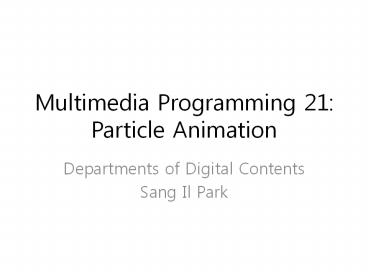Multimedia Programming 21: Particle Animation PowerPoint PPT Presentation
1 / 21
Title: Multimedia Programming 21: Particle Animation
1
Multimedia Programming 21Particle Animation
- Departments of Digital Contents
- Sang Il Park
2
Outline
- Review Playing with Video
- Particle Systems
3
OpenCV Video I/O
- OpenCV? Video Reading Functions
- CvCapture
- cvCaptureFromFile
- cvCaptureFromCAM
- cvReleaseCapture
- cvQueryFrame
- cvGetCaptureProperty
- cvSetCaptureProperty
4
OpenCV Video I/O
- OpenCV? Video Writing Functions
- cvCreateVideoWriter
- cvReleaseVideoWriter
- cvWriteFrame
5
Particle Animation
Reference Reeves W. "Particle Systems -- A
Technique for Modelling a Class of Fuzzy Objets",
Computer Graphics, 17(3), pp. 359-376, 1983
6
Particle Systems
- Particle systems offer a solution to modeling
amorphous, dynamic and fluid objects like clouds,
smoke, water, explosions and fire.
7
Representing Objects with Particles
- An object is represented as clouds of primitive
particles that define its volume rather than by
polygons or patches that define its boundary. - A particle system is dynamic, particles changing
form and moving with the passage of time. - Object is not deterministic, its shape and form
are not completely specified. Instead
8
Particle Systems
- A particle is a point mass
- Mass
- Position
- Velocity
- Acceleration
- Color
- Lifetime
- Use lots of particles to model complex phenomena
- Keep array of particles
9
Particle Systems
- For each frame
- Create new particles and assign attributes
- Delete any expired particles
- Update and move particles based on attributes and
physics - Render particles
10
Particle Generation
- Particles are generated using processes with an
element of randomness. - One way to control the number of particles
created is by the particles generated per frame - Npartsf MeanPartsf Rand() X VariancePartsf
- Another method generates a certain number of
particles per screen area - Npartsf (MeanPartsSAf Rand() X
VariancePartsSAf) X ScreenArea - With this method the number of new particles
depends on the screen size of the object.
11
Particle Attributes
- Initial position
- Initial velocity
- Initial size
- InitialSize MeanSize Rand() X VarSize
- Initial color
- Initial transparency
- Shape
- Lifetime
AliasWavefronts Maya
12
Creating/Deleting Particles
- Where to create particles?
- Around some center
- Along some path
- Surface of shape
- Where particle density is low
- When to delete particles?
- Where particle density is high
- Life span
- Random
13
Example Wrath of Khan
14
Example Wrath of Khan
15
Example Wrath of Khan
16
Particle Systems
- For each frame
- Create new particles and assign attributes
- Delete any expired particles
- Update and move particles based on attributes and
physics - Render particles
17
Equations of Motion
- Newtons Law for a point mass
- f ma
- Update every particle for each time step
- a(t?t) g (gravity-9.8m/sec2)
- v(t?t) v(t) a(t)?t
- p(t?t) p(t) v(t)?t a(t)2?t/2
18
Particle Dynamics
- Other attributes can vary over time as well, such
as color, transparency and size. These rates of
change can be global or they can be stochastic
for each particle.
19
Particle Extinction
- When generated, given a lifetime in frames.
- Lifetime decremented each frame, particle is
killed when it reaches zero. - Kill particles that no longer contribute to image
(transparency below a certain threshold, etc.).
20
Particle Rendering
- For Star Trek II, Reeves made two assumptions
which made things easier for him - assumed particles wouldnt intersect other
geometry (handled occlusion by compositing)
Particles can obscure other objects behind them,
can be transparent, and can cast shadows on other
objects. The objects may be polygons, curved
surfaces, or other particles. - treated particles as point light sources, each
particle contributing a bit to the brightness of
a pixel (avoiding hidden surface detection and
shadows). However, the particles did not
actually cast light on the geometry in the scene
lights had to be added.
21
Star Trek II The Wrath of Khan

